
by Erik Lovestrand | Jun 23, 2022
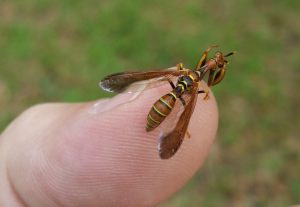
This praying mantis species mimics a wasp to avoid predation. Photo credit: Erik Lovestrand
When it landed on my hand, the first reaction was to brush it off as quickly as possible. However, something seemed to be slightly odd about this particular “wasp” that made me take another look. First, it was not prone to fly away as I moved my hand up for a better look. It even seemed okay with the interaction as I moved it around for a photo opportunity. There was also something odd about the shape of its body that wasn’t exactly wasp-like. As I looked closer, I realized that its head was very mantis-like and when it began grooming its antennae, I could make out the telltale folded arms that give the praying mantis its name. The yellow and black stripes encircling its abdomen, along with its wing shape and positioning veritably shouted “WASP!” I had never heard of a praying mantis that expertly mimicked a wasp so I did a quick internet search and found that this was a wasp mantidfly (neither a wasp nor a mantis). Mantidflies are grouped by scientists into a separate order called Neuroptera, which includes lacewings, antlions, owlflies, and others. Here are a few other mantidflies that mimic other wasp species.
A simple definition of mimicry would be: similarities between different species of animals. It is different from camouflage, which refers to an animal resembling an inanimate object, but both are effective forms of deception that generally benefit an animal in some way. Another common insect that would fool most people is the soldier fly. It definitely looks like something that could sting but closer examination will reveal only one pair of wings (a fly trait) rather than two, as bees and wasps have.
Now, not to take you too far into the weeds on this subject, but we should also mention the different types of mimicry that scientists have identified in nature and note an example of each. Henry Walter Bates studied butterflies in the Amazon and described a type of mimicry where one species mimicked the look of another that had some particularly nasty defense to predation. The mimic was lacking the defense mechanism but benefited by predators avoiding it based on its basic appearance. This type of mimicry is now known as Batesian mimicry and a good example are the butterflies that mimic the monarch. Monarchs are toxic because of the milkweed they eat during their larval stage. After a predator eats a few it learns to avoid anything that looks similar, such as a viceroy or queen butterfly. Fritz Mueller was a German zoologist who described a form of mimicry, now called Muellerian mimicry, where multiple species mimic each other and they all have a similar defense mechanism. This spreads the benefit to all that look similar by reducing predation pressure on all. The third type of mimicry is known as self mimicry, where an animal has one body part that mimics another (i.e. large eye spots to frighten or disorient an attacker), or a body part that may mimic some innocuous thing to fool prey into coming closer. We have a great example of this locally in the alligator snapping turtle. The tip of their tongue has a lure that resembles a worm and is capable of wiggling to enhance its effectiveness in tempting a fish to its doom in the vice-like jaws of the turtle.
Nature never ceases to amaze with the diversity and complexity of adaptations that various animals exhibit to gain an edge on the competition. When it comes to mimicry in the natural world, first impressions are generally wrong. I mean, that’s the point, right?

by Sheila Dunning | Jun 23, 2022
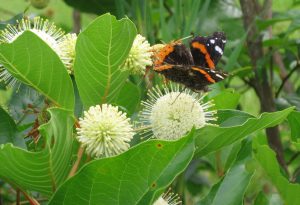 Beginning in 2007 the US Senate, in support of the North American Pollinator Protection Campaign, declared the last week of June as “National Pollinator Week.” As humans, we depend on pollen-moving animals for one out of every three bites of food. Without birds, bees, bats, beetles, butterflies, and various other animals, many flowers would fail to reproduce. In Florida there are numerous native plants that serve as hosts for these pollinators.
Beginning in 2007 the US Senate, in support of the North American Pollinator Protection Campaign, declared the last week of June as “National Pollinator Week.” As humans, we depend on pollen-moving animals for one out of every three bites of food. Without birds, bees, bats, beetles, butterflies, and various other animals, many flowers would fail to reproduce. In Florida there are numerous native plants that serve as hosts for these pollinators.
One of the favorites, due to its heavy flowering over the summer, is Buttonbush (Cephalanthus occidentalis).  It is a semi-aquatic woody shrub to small tree that develops white golf-ball-sized clusters of fragrant flowers, attracting various pollinating animals. Bees of various species, several different wasps, assorted moths and butterflies, flies and even hummingbirds scramble for the flowers’ sweet treat within each of the trumpet shaped flowers. The pincushion-like flower balls stand on two inch stalks in clusters arising from stem tips and leaf axils. They are produced over a long period in late spring and summer. The flowers give way to little reddish-brown nutlets which persist on the through the winter. Buttonbush seeds are important wildlife food, especially for ducks; and the dense, impenetrable tickets provide nesting and escape cover for many wetland birds and herptiles. Buttonbush is a fast-growing wetland plant that can be grown in a naturalized landscape if given supplemental water during dry spells. It is at its best, through, in an area where the soil is frequently wet and can tolerate soggy soils. Buttonbush is not drought or salt tolerant. The deciduous shrub grows well in full sun to partial shade on soils that are acidic to slightly alkaline. The leaves of Buttonbush turn yellow in the fall before dropping off. While short-lived, requiring rejuvenation pruning to improve its longevity, Buttonbush (Cephalanthus occidentalis) serves a critical role to wildlife in the wetland habitat. Deer browse the foliage and twigs. Ducks, especially the mallard, eat the seeds. And, the summer flowers attract bees, butterflies and moths; our wonderful pollinators.
It is a semi-aquatic woody shrub to small tree that develops white golf-ball-sized clusters of fragrant flowers, attracting various pollinating animals. Bees of various species, several different wasps, assorted moths and butterflies, flies and even hummingbirds scramble for the flowers’ sweet treat within each of the trumpet shaped flowers. The pincushion-like flower balls stand on two inch stalks in clusters arising from stem tips and leaf axils. They are produced over a long period in late spring and summer. The flowers give way to little reddish-brown nutlets which persist on the through the winter. Buttonbush seeds are important wildlife food, especially for ducks; and the dense, impenetrable tickets provide nesting and escape cover for many wetland birds and herptiles. Buttonbush is a fast-growing wetland plant that can be grown in a naturalized landscape if given supplemental water during dry spells. It is at its best, through, in an area where the soil is frequently wet and can tolerate soggy soils. Buttonbush is not drought or salt tolerant. The deciduous shrub grows well in full sun to partial shade on soils that are acidic to slightly alkaline. The leaves of Buttonbush turn yellow in the fall before dropping off. While short-lived, requiring rejuvenation pruning to improve its longevity, Buttonbush (Cephalanthus occidentalis) serves a critical role to wildlife in the wetland habitat. Deer browse the foliage and twigs. Ducks, especially the mallard, eat the seeds. And, the summer flowers attract bees, butterflies and moths; our wonderful pollinators.
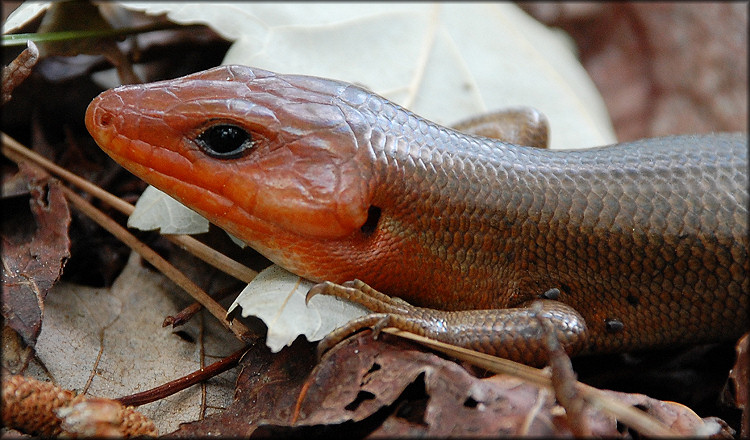
by Erik Lovestrand | May 26, 2022
Well, the answer to this question should be obvious, right? However, when we take a closer look at these interesting creatures, the first impression created by their frightful name will likely evaporate completely. First, scorpions are considered venomous, rather than poisonous (I know, a technicality). They have many predators that eat them with no ill effect so they are not poisonous. Anything that has the ability to deliver a toxin by means of injection is classified as venomous. Next, the name is a true misnomer because the group of animals referred to as blue-tailed scorpions are actually a type of lizard called a skink.
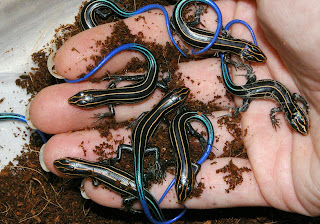
Hatchling broadhead skinks sport a brilliant blue tail but lose this color as they mature. Source: NSF-EID
Scincidae is just one of sixteen families of lizards worldwide but it contains some of the most beautiful species of reptiles. Florida is blessed (yes, blessed) with at least seven species of skinks, with one being divided into five sub-species. Three of the five sub-species of the mole skink have “protected” status under state or federal laws.
Several of our native skinks in the Panhandle are challenging to identify at first glance, particularly during their younger years. The five-lined, southeastern five-lined and broadhead skink are all striped and have blue tails as youngsters, hence the origin of the frightening title for this article. According to folklore, these animals have the ability to deliver a painful sting with their tail. Well, as a lifelong reptile enthusiast, I have had the experience of catching many young, blue-tailed skinks without any stings.
Now, back to the question of whether or not these blue-tailed skinks are poisonous. From everything that I have read, there is no scientific evidence that skinks are inherently toxic when eaten by other animals. It is theorized that they could potentially harbor Salmonella bacteria but I have never heard of a documented case of this either. Many people hold the belief that when a skink in eaten by a dog or cat, it causes the animal to hold its head cocked and wander off to one side when walking. Veterinarians refer to these symptoms as vestibular syndrome and often cannot diagnose a cause. Vestibular syndrome is related to the inner ear or the parts of the brain that control balance and a sense of orientation to gravity. Our family witnessed this once with a beagle that we had and it lasted for several weeks but gradually improved to the point of normalcy. We did not witness her eating a skink, although she could have. However, there are many other more likely causes for this behavior including, inner ear infections, cysts or tumors, head trauma, parasites, etc. I suspect that inner ear issues are a common cause.
The largest species of skink in the Southeastern U. S. is the broadhead (or broad-headed) skink, reaching lengths of nearly thirteen inches. When mature, these skinks lose the blue tail and most of their striping to become a tannish brown. Males are larger than females and have a reddish color on the head, which intensifies during the breeding season. If you want to identify this species as a juvenile, you will need to look at the scales on the underside of the tail to separate it from the two species of five-lined skinks that inhabit our area. The central row of scales will be significantly wider than the other rows on either side. Broadheads have powerful jaws and will bite if harassed. If you want to see two males engaged in epic combat, give a watch to this YouTube link: https://www.youtube.com/watch?v=Z8qbexnZWew . Their stamina is truly amazing and they definitely come out with some battle scars.
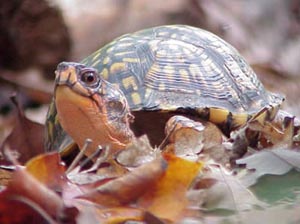
by Kalyn Waters | Apr 29, 2022

Box Turtle. Photo Credit J.D. Willson, University of Georgia
Growing up, or even as an adult there is something exciting about seeing a turtle on the road! We always want to stop and check it out or even help it across. Box Turtles are common in all parts of the southeastern United States. There are four subspecies of box turtles that can be found east of the Mississippi River. Here are three interesting topics about our common box turtles:
Reproduction
With spring in the air and the temperatures rising, they are on the move. There movement is in part due to spring being the beginning of their mating season. In the southeast males and females will mate from spring into the fall. Males will mate with one or multiple females. Amazingly females can lay fertile eggs up to four years following one successful mating! Normal incubation of the eggs typically takes three months.
Lifespan
Box turtles are well developed at birth. As soon as the hatch the start to mature and will grow at a rate of about ½ an inch per year for the first five years. While growth slows dramatically after that, they will continue to grow until they are about 20 years old. It is believed that some box turtles will live to be over 100 years old.
Home Range
While our box turtle friends live a long time, they are homebodies! Their entire home range is typically 250 yards in diameter or less. It is normal to see an overlap of home ranges for box turtles, regardless of sex or age. Keeping in mind the small home range of turtles and their limited ability to travel long distances, you should never pick them up and take them to a new area. If they are crossing a road, only set them to the other side, do not relocate them. In addition, turtles found crossing the roads in June and July are likely pregnant females. These females are likely searching for a nesting site when they are found.
As we move into spring and summer, turtles will become more active. Keep in mind that we should always leave turtles in the wild. They live longer healthier lives and can contribute to their breeding population. Likewise, you should never release a captive turtle into the wild as it will likely not survive and may introduce diseases.

by Laura Tiu | Mar 11, 2022
World Wildlife Day was celebrated on March 3, 2022. This year’s theme is “Recovering key species for ecosystem restoration.” We celebrate this day to bring attention and awareness to many of the plants and animals that are considered threatened and endangered species and highlight efforts to conserve them. It is estimated that over a million species are currently threatened with extinction.

Turkey Creek Niceville, FL (credit E. Zambello)
Florida is considered a very biodiverse state having a great variety ecosystems and unique plants and animals that inhabit these areas. This makes Florida an attractive place to live but can result in increased pollution and land use changes that can be threats to this biodiversity. One local species that experienced this type of pressure is the Okaloosa darter. This tiny 1 to 2 inch fish dwindled to as few as 1,500 individuals surviving when it was declared endangered in 1973. Factors such as its small range, competition from other species, and historical land use practices including artificial impoundments, erosion, and siltation, contributed to its demise.
The Okaloosa darter prefers to live in small, clear, lightly vegetated streams fed by ground water seepage from sand hill areas. This highly specialized habitat is found in only six streams in Okaloosa and Walton Counties and almost exclusively within Eglin Air Force Base’s boundaries. Environmental managers from Eglin Air Force Base partnered with U.S. Fish and Wildlife Service and other agencies and worked diligently to reduce land use impacts and rehab the impaired streams over the past several decades. They reclaimed clay pits near stream headwaters, improved road crossings to reduce sedimentation and enhanced the habitat for the darter.

Okaloosa darter photo credit: FWS.gov
Due to these efforts, the population of Okaloosa Darters has increased to more than 600,000 and the species has now been down listed from endangered to threatened. In fact, the projects have been so successful that the darter is now being considered for delisting as a threatened and endangered species under the Endangered Species Act. This is something to celebrate on this World Wildlife Day as an example of how we can recover key species for ecosystem restoration. The best news is that Eglin Air Force Base’s Jackson Guard Unit is continuing to make on-base conservation a priority, not only for the Okaloosa Darter, but for other plants and animals under their purview.

by Erik Lovestrand | Mar 4, 2022
Many of our local creatures lead fascinating lives that are rarely observed by the casual nature-seeker. However, thanks to those seriously committed naturalists, who may seriously need to be committed, we get the opportunity to peek into the secret lives of newts for some wild revelations. By the way, I do consider myself a naturalist and on occasion will come close to the edge of “crazy” in my nature adventures. Nevertheless, I do not believe I would actually qualify as “committable” because I have never totally lost that innate capacity to be freakishly startled when a treefrog jumps on the back of my neck in the dark. If you ever get past the point of being startled by things like that when on a nighttime herp hunting venture, you should probably speak with a professional.
Several months ago, I once again decided to test my measure of “committability” on a late night visit to the sinkhole pond behind my house. I was hoping to see what kinds of local amphibians might be active because I could hear several different frog species sounding off. As I waded in with my headlamp for a light source, I soon discovered that frogs are pretty darn good at not getting caught at night (imagine that). I had a dip net but never got close enough without scaring the quarry under. However, when I made a few scoops across the bottom in the shallows I was excited to see something wriggling among the leafy debris in the net.
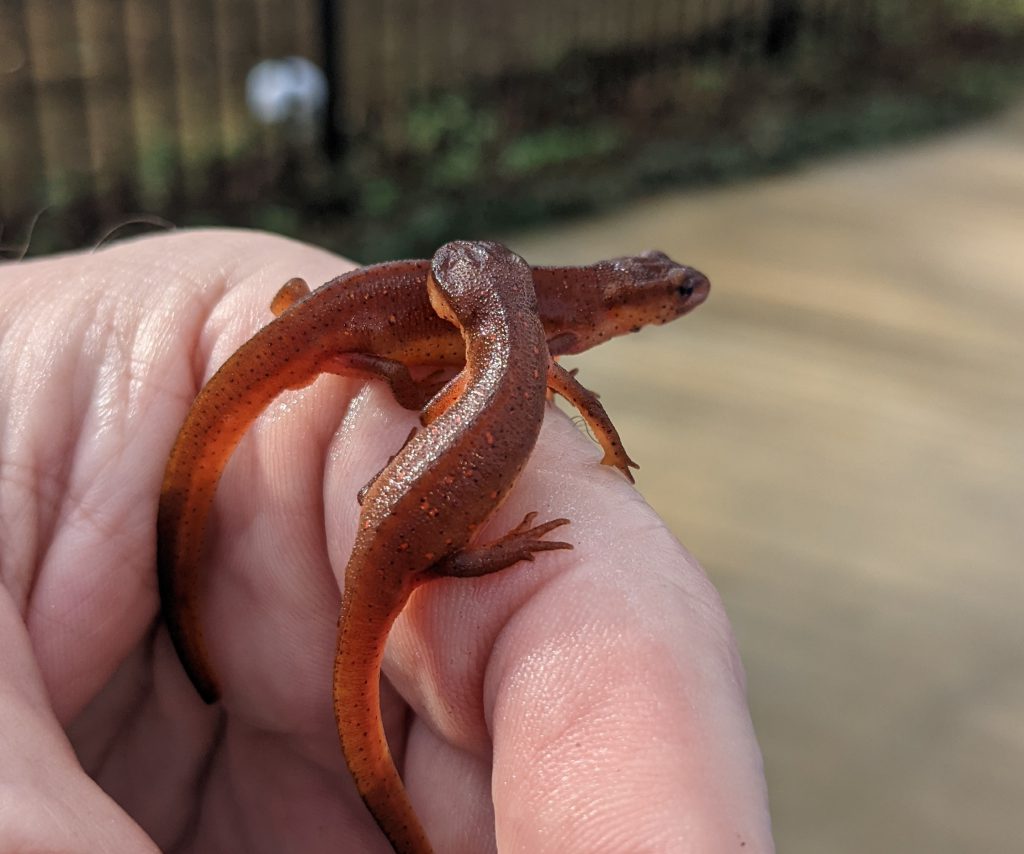
These two “eft-phase” eastern newts were rescued from the authors pool skimmer
Upon returning to the house, it didn’t take long to identify the three-inch long specimen as an eastern newt. As I later read more in depth about this species, I learned that newts are in the family called Salamandridae and typically (not always) have three distinct life phases where they go back and forth between the land and water. After the eggs hatch, larval newts are fully aquatic, with a pair of feathery external gills protruding behind their head. As they mature, they metamorphose into a bright orange/red color and no longer have external gills. They then leave the water for a terrestrial phase where they are called “efts.” Efts may wander the forest floor for many years and travel long distances before once again returning to the water as an adult to breed. Back in the aquatic environment, they morph into a different looking creature yet again. The external gills do not return but the skin color goes from brightly colored to a greenish-yellow and the tail develops a flattened ridge that aids in swimming. All phases have tiny, bright red dots on the body that are circled by black rings, hence their other name, the red-spotted newt. The skin of the eastern newt is also toxic and scientists refer to the bright coloration of the eft as “aposematic” or warning coloration. Their toxicity allows this species to co-exist with fish, unlike some other salamanders that would become tasty snacks and not likely survive to adulthood. The eastern newt is widespread throughout eastern North America and has been intensely studied for its amazing ability to regenerate lost body parts. Not just limbs but even organ tissues!
So the next time you want to test whether or not you might qualify as a hardcore naturalist (i.e. certifiably nuts), take a nighttime trek into a dark, watery, scary place alone. Pay close attention to your reaction when something moves under your foot on the squishy bottom. I would wager that most of you would fall somewhere just shy of being a true hardcore naturalist. I would even put money on it. Have fun!













